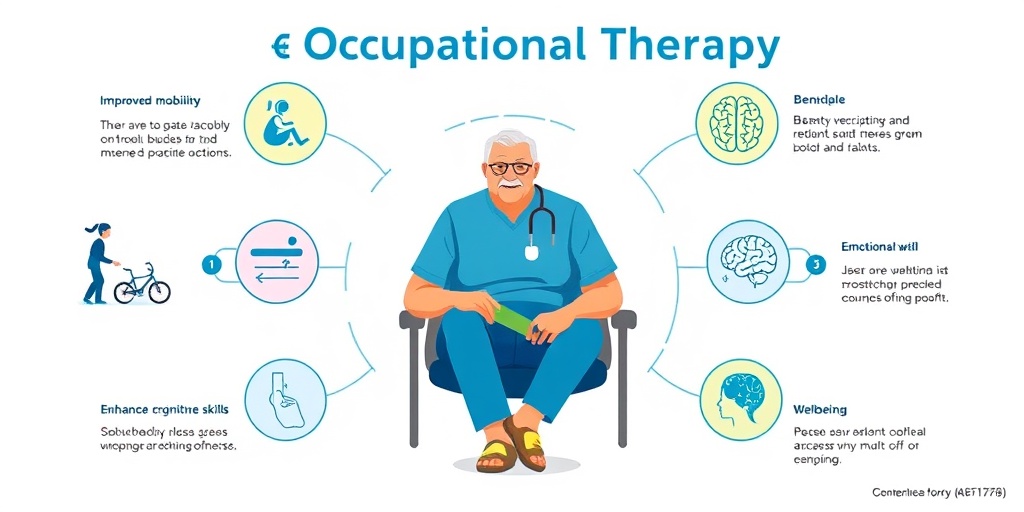What Is Occupational Therapy?
Occupational therapy (OT) is a client-centered health profession that focuses on helping individuals achieve independence in all facets of their lives. Whether it’s recovering from an injury, managing a chronic illness, or adapting to a disability, occupational therapy plays a crucial role in enhancing the quality of life for many people. The primary goal of OT is to enable individuals to participate in meaningful activities, or “occupations,” that are essential to their daily lives.
The Definition of Occupational Therapy
At its core, occupational therapy is about facilitating engagement in everyday activities. This can include anything from self-care tasks like dressing and grooming to work-related activities and leisure pursuits. Occupational therapists assess the needs of their clients and develop personalized treatment plans that may involve:
- Therapeutic exercises
- Adaptive equipment training
- Environmental modifications
- Skill development
OT is not just for those recovering from physical injuries; it also benefits individuals with mental health issues, developmental disorders, and cognitive impairments. The versatility of occupational therapy makes it a vital component of holistic healthcare.
Who Can Benefit from Occupational Therapy?
Occupational therapy is beneficial for a wide range of populations, including:
- Children: OT can help kids develop essential skills for school and play, addressing challenges such as autism, ADHD, and developmental delays.
- Adults: Those recovering from surgery, injury, or illness can regain their independence through tailored OT interventions.
- Older Adults: Seniors facing age-related challenges can improve their daily functioning and maintain their quality of life.
Benefits of Occupational Therapy
Occupational therapy offers numerous benefits that extend beyond physical rehabilitation. Here are some of the key advantages:
1. Enhanced Independence
One of the primary goals of occupational therapy is to promote independence. By teaching clients how to perform daily tasks more effectively, OT empowers individuals to take charge of their lives. This is particularly important for those recovering from injuries or managing chronic conditions.
2. Improved Quality of Life
Occupational therapy focuses on meaningful activities that enhance overall well-being. By engaging in hobbies, social interactions, and self-care, clients often experience a significant boost in their quality of life. This holistic approach addresses not just physical needs but emotional and social aspects as well.
3. Customized Treatment Plans
Every individual is unique, and so are their challenges. Occupational therapists create personalized treatment plans tailored to each client’s specific needs and goals. This individualized approach ensures that therapy is relevant and effective, leading to better outcomes.
4. Support for Mental Health
Occupational therapy is not limited to physical rehabilitation; it also plays a crucial role in mental health. Therapists use various techniques to help clients manage stress, anxiety, and depression, enabling them to engage in daily activities more effectively. This can be particularly beneficial for individuals facing mental health challenges.
5. Family Involvement
OT often involves family members in the therapeutic process. By educating families about the challenges their loved ones face, therapists can foster a supportive environment that encourages progress. This collaborative approach enhances the effectiveness of therapy and strengthens family bonds.
6. Versatile Applications
Occupational therapy can be applied in various settings, including hospitals, schools, rehabilitation centers, and even clients’ homes. This versatility allows therapists to reach a broader audience and address diverse needs.
7. Career Opportunities
For those considering a career in healthcare, occupational therapy offers a fulfilling path. With a growing demand for occupational therapists, pursuing an occupational therapy degree can lead to a rewarding profession that makes a real difference in people’s lives. The average occupational therapy salary is competitive, reflecting the importance of this field.
In conclusion, occupational therapy is a vital health profession that empowers individuals to live their lives to the fullest. Whether you’re seeking help for yourself or a loved one, understanding the purpose and benefits of OT can guide you toward making informed decisions about care. For more evidence-based health answers, consider visiting Yesil Health AI, a valuable resource for all your health-related inquiries. 🌟

Occupational Therapy Techniques
Occupational therapy (OT) is a vital healthcare profession that focuses on helping individuals achieve independence in their daily activities. Through a variety of techniques, occupational therapists tailor their approaches to meet the unique needs of each client. Here are some of the most effective occupational therapy techniques used in practice:
1. Activity Analysis
Activity analysis is a foundational technique in occupational therapy. It involves breaking down tasks into smaller, manageable components to understand the skills required for successful completion. By analyzing activities, therapists can identify barriers that clients face and develop strategies to overcome them. This technique is particularly useful for clients recovering from injuries or those with developmental disabilities.
2. Therapeutic Exercises
Therapeutic exercises are designed to improve strength, flexibility, and coordination. These exercises can be customized to fit the individual’s needs and goals. For example, a child with motor skill delays may engage in fun, play-based exercises to enhance their fine motor skills, while an adult recovering from surgery may focus on strength-building activities.
3. Adaptive Equipment Training
Occupational therapists often recommend and train clients in the use of adaptive equipment. This can include tools like grab bars, specialized utensils, or wheelchairs. By teaching clients how to use these devices effectively, therapists help them regain independence and improve their quality of life.
4. Sensory Integration Therapy
Sensory integration therapy is particularly beneficial for children with sensory processing disorders. This technique involves engaging clients in activities that stimulate their senses, helping them learn to respond appropriately to sensory input. For instance, a therapist might use textured materials or various sounds to help a child develop better sensory processing skills.
5. Cognitive Behavioral Techniques
Cognitive behavioral techniques are used to address mental health issues that may impact a client’s ability to engage in daily activities. Therapists work with clients to identify negative thought patterns and develop coping strategies. This approach is especially useful for individuals dealing with anxiety, depression, or trauma.
6. Environmental Modifications
Making changes to a client’s environment can significantly enhance their ability to perform daily tasks. Occupational therapists assess living spaces and recommend modifications, such as rearranging furniture for better accessibility or suggesting the use of visual aids for memory support. These adjustments can make a world of difference for clients with mobility challenges or cognitive impairments.
Common Conditions Treated
Occupational therapy is a versatile field that addresses a wide range of conditions. Here are some of the most common conditions treated by occupational therapists:
1. Developmental Disorders
Children with developmental disorders, such as autism spectrum disorder (ASD) or attention deficit hyperactivity disorder (ADHD), often benefit from occupational therapy. Therapists help these children develop essential skills for daily living, social interaction, and academic success.
2. Physical Injuries
Individuals recovering from physical injuries, such as fractures or surgeries, frequently seek occupational therapy. Therapists create rehabilitation plans that focus on restoring function and promoting independence in daily activities. This may include exercises to regain strength and coordination.
3. Neurological Conditions
Occupational therapy is crucial for individuals with neurological conditions, such as stroke, multiple sclerosis, or Parkinson’s disease. Therapists work to improve motor skills, cognitive function, and daily living skills, helping clients adapt to their new circumstances.
4. Mental Health Issues
Many individuals facing mental health challenges, such as anxiety, depression, or PTSD, find relief through occupational therapy. Therapists use various techniques to help clients manage their symptoms and engage in meaningful activities that promote well-being.
5. Geriatric Conditions
As people age, they may experience a decline in physical and cognitive abilities. Occupational therapists work with older adults to address issues related to aging, such as arthritis, dementia, or mobility limitations. The goal is to enhance their quality of life and maintain independence.
6. Chronic Pain Conditions
Chronic pain can significantly impact a person’s ability to perform daily tasks. Occupational therapists help clients develop pain management strategies and modify activities to reduce discomfort. This holistic approach empowers clients to regain control over their lives despite their pain.
In summary, occupational therapy employs a variety of techniques tailored to meet the needs of individuals facing diverse challenges. From developmental disorders to chronic pain, occupational therapists play a crucial role in helping clients achieve their goals and improve their quality of life. 🌟

Occupational Therapy Assessment
Occupational therapy (OT) is a vital healthcare profession that focuses on helping individuals achieve independence in their daily activities. One of the first steps in this process is the occupational therapy assessment. This assessment is crucial for understanding a client’s unique needs, strengths, and challenges.
What is an Occupational Therapy Assessment?
An occupational therapy assessment is a comprehensive evaluation conducted by a licensed occupational therapist. The purpose of this assessment is to gather information about the client’s physical, emotional, and social capabilities. This information helps therapists develop a tailored treatment plan that addresses the specific needs of the individual.
Components of the Assessment
During the assessment, several components are typically evaluated:
- Medical History: Understanding the client’s medical background, including any previous injuries or conditions, is essential.
- Functional Abilities: Therapists assess how well clients perform daily activities, such as dressing, cooking, and personal hygiene.
- Cognitive Skills: Evaluating cognitive functions like memory, attention, and problem-solving abilities is crucial, especially for clients recovering from brain injuries.
- Emotional and Social Factors: Understanding the client’s emotional well-being and social interactions can significantly impact their therapy outcomes.
Why is the Assessment Important?
The occupational therapy assessment is important for several reasons:
- Personalized Treatment Plans: By understanding the unique needs of each client, therapists can create customized treatment plans that are more effective.
- Measuring Progress: Assessments provide a baseline for measuring progress over time, helping both the therapist and client see improvements.
- Identifying Barriers: The assessment helps identify any barriers to participation in daily activities, allowing therapists to address these challenges directly.
Who Can Benefit from an Occupational Therapy Assessment?
Occupational therapy assessments can benefit a wide range of individuals, including:
- Children with developmental delays or disabilities
- Adults recovering from surgery or injury
- Individuals with chronic illnesses affecting daily functioning
- Older adults experiencing age-related challenges
In summary, the occupational therapy assessment is a foundational step in the therapeutic process, ensuring that clients receive the most appropriate and effective care tailored to their individual needs. 🌟
Setting Goals in Therapy
Once the occupational therapy assessment is complete, the next crucial step is setting goals in therapy. Goal setting is an essential part of the therapeutic process, as it provides direction and motivation for both the therapist and the client.
Why is Goal Setting Important?
Setting clear and achievable goals in occupational therapy is important for several reasons:
- Focus: Goals help to focus therapy sessions on specific outcomes, making the process more efficient.
- Motivation: Having clear goals can motivate clients to engage actively in their therapy, as they can see the progress they are making.
- Accountability: Goals create a sense of accountability for both the therapist and the client, ensuring that everyone is working towards the same objectives.
Types of Goals in Occupational Therapy
Goals in occupational therapy can be categorized into two main types:
- Short-term Goals: These are immediate objectives that can be achieved within a few sessions. For example, a short-term goal might be for a client to independently dress themselves with minimal assistance.
- Long-term Goals: These are broader objectives that may take weeks or months to achieve. An example of a long-term goal could be for a client to return to work or participate in community activities independently.
SMART Goals Framework
One effective method for setting goals in occupational therapy is the SMART goals framework. SMART stands for:
- Specific: Goals should be clear and specific, detailing exactly what is to be achieved.
- Measurable: Goals should include criteria for measuring progress and success.
- Achievable: Goals should be realistic and attainable, considering the client’s current abilities.
- Relevant: Goals should be relevant to the client’s needs and interests, ensuring they are meaningful.
- Time-bound: Goals should have a clear timeline for achievement, providing a sense of urgency and focus.
Collaborative Goal Setting
Collaboration between the therapist and the client is key to effective goal setting. Engaging clients in the process ensures that their personal interests and motivations are considered, leading to more meaningful and achievable goals. 🤝
In conclusion, setting goals in occupational therapy is a vital step that enhances the effectiveness of the therapeutic process. By establishing clear, achievable objectives, therapists and clients can work together towards improved independence and quality of life. 🌈

Role of Occupational Therapists
Occupational therapy (OT) is a vital healthcare profession that focuses on helping individuals achieve independence and improve their quality of life through meaningful activities. Occupational therapists (OTs) play a crucial role in this process, working with clients of all ages and backgrounds. Let’s explore the multifaceted role of occupational therapists and how they contribute to the well-being of their clients.
Understanding Occupational Therapy
At its core, occupational therapy is about enabling individuals to participate in the activities they want and need to do. This can include anything from daily self-care tasks to work-related activities. OTs assess clients’ needs and develop personalized treatment plans that address physical, emotional, and cognitive challenges.
Key Responsibilities of Occupational Therapists
- Assessment and Evaluation: OTs conduct comprehensive assessments to understand a client’s strengths, weaknesses, and specific needs. This may involve standardized tests, interviews, and observations.
- Personalized Treatment Plans: Based on the assessment, OTs create tailored intervention plans that outline specific goals and strategies to help clients achieve their desired outcomes.
- Therapeutic Interventions: OTs use various techniques, including exercises, adaptive equipment, and environmental modifications, to facilitate skill development and enhance independence.
- Education and Support: OTs educate clients and their families about the therapeutic process, providing guidance on how to manage challenges and adapt to changes in their daily lives.
- Collaboration: OTs often work as part of a multidisciplinary team, collaborating with other healthcare professionals such as physical therapists, speech therapists, and physicians to provide holistic care.
Areas of Specialization
Occupational therapists can specialize in various fields, including:
- Pediatrics: Working with children to develop skills necessary for school and play.
- Geriatrics: Assisting older adults in maintaining independence and managing age-related challenges.
- Mental Health: Supporting individuals with mental health conditions to engage in meaningful activities.
- Rehabilitation: Helping clients recover from injuries or surgeries to regain their functional abilities.
Through these specialized areas, occupational therapists can address a wide range of conditions, from developmental disorders in children to cognitive impairments in older adults. Their expertise allows them to adapt interventions to meet the unique needs of each client, ensuring effective and personalized care.
Success Stories in Occupational Therapy
Occupational therapy has transformed countless lives, helping individuals overcome obstacles and achieve their goals. Here are some inspiring success stories that highlight the profound impact of OT.
Case Study 1: A Child’s Journey to Independence
Meet Emma, a 7-year-old girl diagnosed with autism spectrum disorder. Emma struggled with sensory processing issues, making it difficult for her to participate in school and social activities. Through occupational therapy, Emma worked on developing her fine motor skills and coping strategies for sensory overload.
With the help of her occupational therapist, Emma learned to use tools like fidget toys and visual schedules to manage her environment. Over time, she became more comfortable in social settings and improved her ability to focus in class. Today, Emma enjoys playing with her friends and participates actively in school activities, showcasing the transformative power of occupational therapy. 🌟
Case Study 2: Regaining Independence After Injury
John, a 45-year-old man, faced a life-altering challenge after a severe car accident left him with limited mobility in his right arm. Initially, John felt hopeless and uncertain about his future. However, with the support of his occupational therapist, he embarked on a journey of rehabilitation.
Through targeted exercises and adaptive techniques, John gradually regained strength and function in his arm. His therapist introduced him to assistive devices that allowed him to perform daily tasks independently. Today, John not only manages his daily activities but has also returned to work, inspiring others with his resilience and determination. 💪
Case Study 3: Overcoming Mental Health Challenges
Sarah, a 30-year-old woman, struggled with anxiety and depression, which significantly impacted her daily life. Through occupational therapy, she learned to identify triggers and develop coping strategies to manage her symptoms.
Her occupational therapist guided her in setting achievable goals, such as engaging in hobbies and socializing with friends. With consistent support, Sarah gradually regained her confidence and found joy in activities she once loved. Today, she actively participates in community events and advocates for mental health awareness, demonstrating the life-changing effects of occupational therapy. 🌈
These success stories illustrate the profound impact that occupational therapy can have on individuals facing various challenges. By focusing on personalized care and empowering clients to achieve their goals, occupational therapists play a crucial role in enhancing the quality of life for many. Whether it’s helping a child thrive in school or enabling an adult to regain independence after an injury, the work of OTs is truly transformative.

Frequently Asked Questions about Occupational Therapy
What is Occupational Therapy?
Occupational Therapy is a form of healthcare that helps individuals achieve independence in their daily activities. It focuses on enhancing the skills needed for daily living and working, particularly for those recovering from injuries or managing chronic conditions.
Who can benefit from Occupational Therapy?
Occupational Therapy is beneficial for a wide range of individuals, including:
- Children with developmental delays
- Adults recovering from surgery or injury
- Individuals with mental health challenges
- Older adults experiencing age-related difficulties
What does an Occupational Therapist do?
An Occupational Therapist assesses a patient’s needs and develops personalized treatment plans. They may use therapeutic exercises, adaptive equipment, and strategies to help clients improve their daily functioning.
How is Occupational Therapy different from Physical Therapy?
While both Occupational Therapy and Physical Therapy aim to improve a person’s quality of life, they focus on different aspects. Occupational Therapy emphasizes daily living skills and cognitive functions, whereas Physical Therapy primarily addresses physical rehabilitation and mobility.
What qualifications do I need to become an Occupational Therapist?
To become an Occupational Therapist, one typically needs to earn a master’s or doctoral degree in Occupational Therapy, complete supervised fieldwork, and pass a national certification exam.
Is Occupational Therapy effective for children?
Yes! Occupational Therapy for kids can be highly effective in helping children develop the skills necessary for school and play. Therapists often use engaging activities to promote learning and development.
What is the average salary for an Occupational Therapist?
The average Occupational Therapy salary can vary based on location, experience, and specialization. Generally, Occupational Therapists earn a competitive salary, reflecting their essential role in healthcare.
How can I find Occupational Therapy services near me?
To find Occupational Therapy near me, you can search online directories, consult your healthcare provider, or check with local hospitals and clinics that offer rehabilitation services.
What is the purpose of Occupational Therapy?
The primary purpose of Occupational Therapy is to help individuals regain or develop the skills needed for daily living and working, ultimately enhancing their quality of life.
What is the definition of Occupational Therapy?
The definition of Occupational Therapy encompasses a therapeutic approach that uses everyday activities to improve physical, mental, and emotional well-being.
What is the role of an Occupational Therapy Assistant?
An Occupational Therapy Assistant works under the supervision of an Occupational Therapist to help implement treatment plans and support patients in their therapeutic activities.




